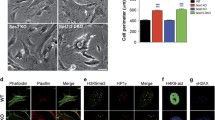Abstract
Mouse embryonic fibroblasts (MEF) with point mutation in somatic cytochrome C gene were generated and characterized. It was shown that the substitution of lysine for tryptophan in position 72 (K72W) decreased the proapoptotic functions of cytochrome C in response to staurosporin treatment without disrupting its respiratory functions. The presence of this mutation did not affect the pattern of cytochrome C gene expression or its localization inside the cell. These cell lines therefore represent an interesting model for the study of apoptotic signaling and physiological functions of cytochrome C.
Similar content being viewed by others
References
Skulachev V.P. 2006. Bioenergetic aspects of apoptosis, necrosis and mitoptosis. Apoptosis. 11, 473–485.
Ow Y.P., Green D.R., Hao Z., Mak T.W. 2008. Cytochrome c: Functions beyond respiration. Nature Rev. Mol. Cell Biol. 9, 532–542.
Vempati U.D., Diaz F., Barrientos A., Narisawa S., Mian A.M., Millan J.L., Boise L.H., Moraes C.T. 2007. Role of cytochrome c in apoptosis: Increased sensitivity to tumor necrosis factor alpha is associated with respiratory defects but not with lack of cytochrome c release. Mol. Cell Biol. 27, 1771–1783.
Hake L.E., Kuemmerle N., Hecht N.B., Kozak C.A., Zou H., Li Y., Liu X., Wang X. 1994. The genes encoding the somatic and testis-specific isotypes of the mouse cytochrome c genes map to paralogous regions of chromosomes 6 and 2. Genomics. 20, 503–505.
Zou H., Li Y., Liu X., Wang X. 1999. An APAF-1 cytochrome c multimeric complex is a functional apoptosome that activates procaspase-9. J. Biol. Chem. 274, 11549–11556.
Yu T., Wang X., Purring-Koch C., Wei Y., McLendon G.L. 2001. A mutational epitope for cytochrome C binding to the apoptosis protease activation factor-1. J. Biol. Chem. 276, 13034–13038.
Kluck R.M., Ellerby L.M., Ellerby H.M., Naiem S., Yaffe M.P., Margoliash E., Bredesen D., Mauk A.G., Sherman F., Newmeyer D.D. 2000. Determinants of cytochrome c pro-apoptotic activity: The role of lysine 72 trimethylation. J. Biol. Chem. 275, 16127–16133.
Hao Z., Duncan G.S., Chang C.C., Elia A., Fang M., Wakeham A., Okada H., Calzascia T., Jang Y., You-Ten A., Yeh W.C., Ohashi P., Wang X., Mak T.W. 2005. Specific ablation of the apoptotic functions of cytochrome c reveals a differential requirement for cytochrome C and Apaf-1 in apoptosis. Cell. 121, 579–591.
Li K., Li Y., Shelton J.M., Richardson J.A., Spencer E., Chen Z.J., Wang X., Williams R.S. 2000. Cytochrome c deficiency causes embryonic lethality and attenuates stress-induced apoptosis. Cell. 101, 389–399.
Cecconi F., Varez-Bolado G., Meyer B.I., Roth K.A., Gruss P. 1998. Apaf1 (CED-4) homolog regulates programmed cell death in mammalian development. Cell. 94, 727–737.
Yoshida H., Kong Y.Y., Yoshida R., Elia A.J., Hakem A., Hakem R., Penninger J.M., Mak T.W. 1998. Apaf1 is required for mitochondrial pathways of apoptosis and brain development. Cell. 94, 739–750.
Kuida K., Haydar T.F., Kuan C.Y., Gu Y., Taya C., Karasuyama H., Su M.S., Rakic P., Flavell R.A. 1998. Reduced apoptosis and cytochrome c-mediated caspase activation in mice lacking caspase 9. Cell. 94, 325–337.
Hakem R., Hakem A., Duncan G.S., Henderson J.T., Woo M., Soengas M.S., Elia A., de la Pompa J.L., Kagi D., Khoo W., Potter J., Yoshida R., Kaufman S.A., Lowe S.W., Penninger J.M., Mak T.W. 1998. Differential requirement for caspase 9 in apoptotic pathways in vivo. Cell. 94, 339–352.
Kuida K., Zheng T.S., Na S., Kuan C., Yang D., Karasuyama H., Rakic P., Flavell R.A. 1996. Decreased apoptosis in the brain and premature lethality in CPP32-deficient mice. Nature. 384, 368–372.
Woo M., Hakem R., Soengas M.S., Duncan G.S., Shahinian A., Kagi D., Hakem A., McCurrach M., Khoo W., Kaufman S.A., Senaldi G., Howard T., Lowe S.W., Mak T.W. 1998. Essential contribution of caspase 3/CPP32 to apoptosis and its associated nuclear changes. Genes. Dev. 12, 806–819.
Boon-Unge K., Yu Q., Zou T., Zhou A., Govitrapong P., Zhou J. 2007. Emetine regulates the alternative splicing of Bcl-x through a protein phosphatase 1-dependent mechanism. Chem. Biol. 14, 1386–1392.
Kluck R.M., Martin S.J., Hoffman B.M., Zhou J.S., Green D.R., Newmeyer D.D. 1997. Cytochrome c activation of CPP32-like proteolysis plays a critical role in a Xenopus cell-free apoptosis system. EMBO J. 16, 4639–4649.
Sharonov G.V., Feofanov A.V., Bocharova O.V., Astapova M.V., Dedukhova V.I., Chernyak B.V., Dolgikh D.A., Arseniev A.S., Skulachev V.P., Kirpichnikov M.P. 2005. Comparative analysis of proapoptotic activity of cytochrome c mutants in living cells. Apoptosis. 10, 797–808.
Chertkova R.V., Sharonov G.V., Feofanov A.V., Bocharova O.V., Latypov R.F., Chernyak B.V., Arseniev A.S., Dolgikh D.A., Kirpichnikov M.P. 2008. Proapoptotic activity of cytochrome c in living cells: Effect of K72 substitutions and species differences. Mol. Cell Biochem. 314, 85–93.
King M.P. Attardi G. 1989. Human cells lacking mtDNA: Repopulation with exogenous mitochondria by complementation. Science. 246, 500–503.
Chernyak B.V., Pletjushkina O.Y., Izyumov D.S., Lyamzaev K.G., Avetisyan A.V. 2005. Bioenergetics and death. Biochemistry (Moscow). 2, 240–245.
Abdullaev Z.K., Bodrova M.E., Chernyak B.V., Dolgikh D.A., Kluck R.M., Pereverzev M.O., Arseniev A.S., Efremov R.G., Kirpichnikov M.P., Mokhova E.N., Newmeyer D.D., Roder H., Skulachev V.P. 2002. A cytochrome c mutant with high electron transfer and antioxidant activities but devoid of apoptogenic effect. Biochem. J. 362, 749–754.
Green D.R. 2005. Apoptotic pathways: Ten minutes to dead. Cell. 121, 671–674.
Lavrik I., Golks A., Krammer P.H. 2005. Death receptor signaling. J. Cell Sci. 118, 265–267.
Micheau O. Tschopp J. 2003. Induction of TNF receptor I-mediated apoptosis via two sequential signaling complexes. Cell. 114, 181–190.
Author information
Authors and Affiliations
Corresponding author
Additional information
Original Russian Text © I.A. Mufazalov, D.N. Penkov, B.V. Chernyak, O.Y. Pletjushkina, M.Y. Vyssokikh, R.V. Chertkova, M.P. Kirpichnikov, D.A. Dolgikh, A.A. Kruglov, D.V. Kuprash, V.P. Skulachev, S.A. Nedospasov, 2009, published in Molekulyarnaya Biologiya, 2009, Vol. 43, No. 4, pp. 648–656.
Rights and permissions
About this article
Cite this article
Mufazalov, I.A., Penkov, D.N., Chernyak, B.V. et al. Preparation and characterization of mouse embryonic fibroblasts with K72W mutation in somatic cytochrome C gene. Mol Biol 43, 596–603 (2009). https://doi.org/10.1134/S0026893309040116
Received:
Accepted:
Published:
Issue Date:
DOI: https://doi.org/10.1134/S0026893309040116




